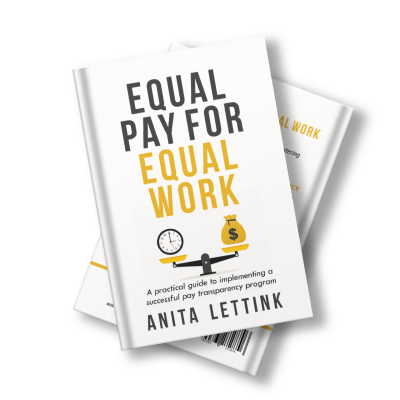Equal Pay for Equal Work: ‘Pay transparency is not only the law – it’s a good business practice’
In an exclusive interview, Anita Lettink discusses pay transparency and equal pay, as well as how EU businesses can prepare themselves for the 2027 law change.
UNLEASH Books | Expert Insight
In the European Union, the average gender pay gap is between 12-13%.
Anita Lettink's book, Equal Pay for Equal Work, is the ultimate guide to support businesses through the upcoming Pay Transparency legislation.
In an exclusive interview, Lettink, who has more than 20 years of experience working in the HR and payroll space, discovers how businesses can prepare for this new legislation.
Last time you went to the shops to buy a loaf of bread, you probably had a rough idea of what it would cost, right? And you would rightfully expect a budget clothing shop to sell cheaper t-shirts than a designer boutique.
Well, this is because we all have a rough idea of what pricing should be – because having prices on display is an example of transparency.
Now, last time you looked for a job, how many job descriptions included a pay range?
More often than not, candidates can trawl through lengthy recruitment processes to find that the salary doesn’t quite match their expectations.
On top of all this, in 2024, we still haven’t achieved equal pay. That’s right. Men still out earn women for the same work. But things are going to have to change, as the EU is welcoming new laws in 2027 to put an end to these problems – once and for all.

Anita Lettink, who has more than 20 years of experience working in the HR and payroll space, shares how her new book, Equal Pay for Equal Work is the ultimate guide to support businesses through this transition. In an exclusive interview with UNLEASH, Lettink gives us the inside track.
Understanding how equal pay and pay transparency will change EU businesses

Anita Lettink
Lettink’s journey began when she accepted a role as a Strategic Advisor for a business that promoted pay transparency and equal pay. Soon after starting, she noticed that in Europe, despite the upcoming Pay Transparency legislation, there wasn’t a lot of noise on the subject – which she wanted to change.
“As I started to understand what establishing equal pay meant for companies and how they must become compliant with the EU Directive, I realized that we’re not too far away from when businesses have to start reporting their pay data,” Lettink says. “In fact, 2027 is only two pay cycles away.
There aren’t enough consultants in the EU to help businesses, and especially small and medium businesses, with their pay transparency projects– which is why I decided to write Equal Pay for Equal Work. I also wanted to provide businesses with the information needed to be compliant – or at least to be able to report a gender pay gap in 2027 that is less than 5%.
“Gender discrimination – as with any discrimination – is legally not allowed. We have the right laws, but we still have pay gaps,” she adds.
In the European Union, the average gender pay gap is between 12-13% – this is known as the unadjusted pay gap. However, Lettink explains that many businesses don’t know whether they pay men and women equally as they don’t measure it.
Because of this, many may well be in line with the necessary legislation – they just don’t know it.
However, Lettink states that all companies with 150 employees or more must publicly report in 2027. Reporting a gender pay gap over 5% will “not be a good look”.
This also relates to the aforementioned issue around salary transparency when applying for a job. Lettink explains that candidates – especially those in the younger generation – will instantly be put off jobs unless they state their salary range.
“If I were to get promoted within a company,” Lettink explains, “I would want to know the salary range I can expect, but many businesses keep this a secret. Well, all the secrecy is simply not accepted anymore.
“After all, taking a job at a new company is always somewhat of a risk. So you want to ensure that you’re at least moving to a position that will provide you with better salary growth expectations.”
Key take home points for HR leaders
So, how does Equal Pay for Equal Work help ready businesses for these challenges that await?
Well, the book provides step-by-step guidance on designing, implementing, and managing a successful pay transparency program tailored to specific organization’s needs, as well as sharing proven tips for effectively communicating and engaging employees and leaders. In the book you can follow the equal pay journey of a fictitious company, which gives you practical ideas of what you might encounter.
Lettink also shares best practices for addressing challenges and overcoming resistance during the transition to a more equitable pay structure, while sharing expert insights on navigating legal and ethical considerations.
To motivate HR leaders to think and act now, Lettink shares three take-home pieces of advice for businesses.
She says: “Pay transparency is not only the law: it’s a good business practice. Just following the law won’t deliver the results you need. Instead, businesses should focus on being compliant and in line with legislation.
“Additionally, even though 2027 seems like a long way off, businesses should act now – particularly as they will need to report on compensation data of 2026.
“Finally, every company has enough data to start running their first reports. The directive is very prescriptive in what is needed to run reports: salary data, but also benefits and compensation data, too.
“So although it may take some time to get that all together, it’s better to start with what you have so you can get some experience with the reports. This will also show you how close or far off you are to that all-important 5%.
“People should not underestimate how powerful pay transparency is – especially when reaching out to new candidates,” Lettink concludes.

Find Equal Pay for Equal Work, here.
Sign up to the UNLEASH Newsletter
Get the Editor’s picks of the week delivered straight to your inbox!

Senior Journalist
Lucy Buchholz is an experienced business reporter, she can be reached at lucy.buchholz@unleash.ai.
